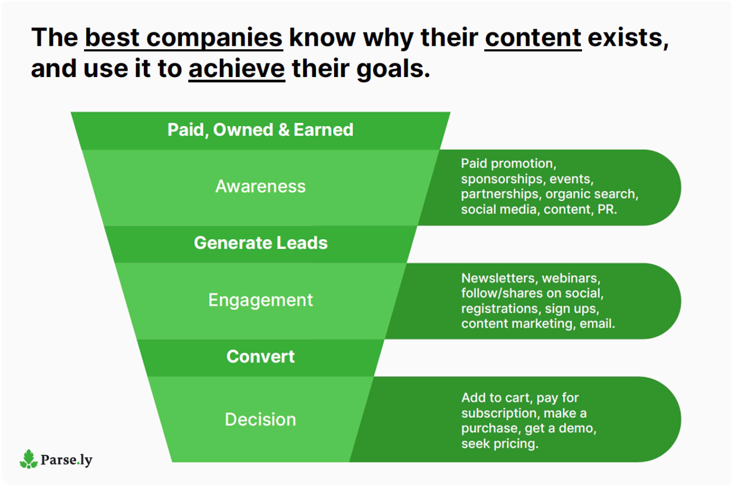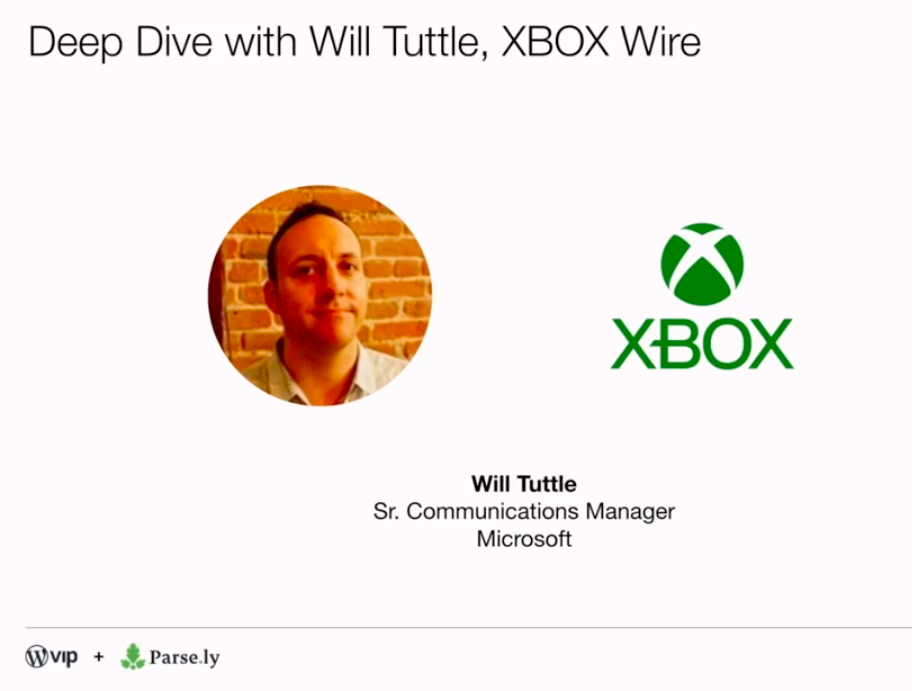How Microsoft XBox is Using Content Analytics to Capitalize on Rapid Growth | Webinar Recap

Last week, WordPress VIP’s CEO, Nick Gernert, Parse.ly’s Co-Founder, Sachin Kamdar, and Microsoft’s Sr. Communications Manager, Will Tuttle, sat down for a webinar to talk about Parse.ly joining WPVIP and how we’re working together now to bring best-in-class solutions to content teams. Will also shared a detailed account of his team’s experience using Parse.ly at Xbox Wire and how it empowered them to unlock the untapped potential of their content.
On February 5th of this year, Parse.ly joined WPVIP, the leading provider of enterprise WordPress and part of Automattic’s suite of innovative brands. This partnership feels so natural and makes so much sense because what WP has done with democratizing publishing and putting technical power in the hands of creators is exactly what Parse.ly has done with the analytics side of content.
Let’s dig into that a bit to understand how we can better leverage content analytics to improve the contact we create and the impact it has on our business. We’ll look at Will and his team at Xbox Wire as an example of an enterprise brand doing this effectively and use Sachin’s questions to him as a way to organize the discussion.
Table of Contents
- Untapped Potential of Content
- Xbox Wire’s Data-Driven Content Strategy
- How did growth affect their strategy in terms of the value of Xbox wire’s content and their ability to reach consumers directly?
- How did growth change the way they think about data and analytics?
- What does training leadership on analytics actually look like?
- What’s the difference between you working for analytics vs. analytics working for you?
Untapped Potential of Content
People coming from the media and entertainment world know how powerful content can be to drive deep engagement and accelerate audience growth, but oftentimes when we talk to general brands and enterprises, we run into a bit of a barrier in getting that message across.
We want to stress the fact that a brand’s digital presence isn’t just about having a website up anymore, it’s about creating an engaging customer experience with content that ultimately gets people to raise their hand and say ‘hey, let’s talk.’ This is the untapped potential of content that more and more brands are beginning to unlock.
How do you do that? You need to really understand the stages of your customers’ journey throughout your site and create content that helps you push them through your funnel.

It’s not enough to just think about getting people into the top of your funnel; we need to think about the full journey, all the way to conversion. The metrics many marketers are used to looking at don’t capture that, which is why Parse.ly provides more meaningful content metrics that capture how effectively you’re driving awareness of your brand, how deeply your audience is engaged with your content, and what is most effectively driving them to take valuable down-funnel actions on your site.
The best companies we see know why their content exists and use it to achieve their goals, and when that happens, we see magic with their ability to connect content with audience.
Xbox Wire’s Data-Driven Content Strategy

Coming over from the editorial team at IDG, one of the largest video game publishers in the world, Will Tuttle joined Microsoft 8 years ago as the Sr. Comms Manager and Editorial Director for Xbox Wire, the primary news channel for Microsoft Xbox. Today, Xbox Wire is the largest owned news channel by audience and impact that Microsoft has, but its original purpose was to be simply a hub for press releases.
A few years into Will’s work with Xbox Wire, he noticed that their audience consisted of much more than just press people, and it became clear they wanted to be in the know and informed on Xbox straight from the horse’s mouth. The site’s traffic quickly grew quickly into the range of millions of pageviews per month.
How did growth affect their strategy in terms of the value of Xbox wire’s content and their ability to reach consumers directly?
The biggest way was that they were able to show their worth to their publishing partners and folks within the company. Being able to say they reach millions of people every day is an important thing for publishers who want to get their word out there, and a lot more value was placed on Xbox Wire internally. They also started getting alot internal and external requests to do more storytelling around their product releases, giving people a behind the scenes look at why they make the products they make. They found that creating that type of content is really engaging for their audience and makes them more likely to spend with them.
How did growth change the way they think about data and analytics?
Will’s team found ways to use analytics wherever they can to inform what they’re doing, whether that’s figuring out what’s bringing people to the site, what they can do to keep them there, or where they’re going after reading an article.
He’s been really focused on training executives and other folks to start thinking about analytics differently as well. Pageviews in the past was their end-all-be-all metric, but Will started highlighting metrics that get to the bottom of what’s driving valuable, deep engagement with their content, like engaged-time.
Engaged-time is especially important for Will’s team to make sure the long-form content they spend lots of time creating is actually being read by their audience. A very long piece with very low engaged-time indicates that readers are not actually spending time consuming it and the efforts to create it may have been a waste.
Will’s team found that many times it’s more valuable to create shorter pieces of content with lots of links out to other content on the site than to create huge, comprehensive pieces.
What does training leadership on analytics actually look like?
A lot of times, Will approaches leadership with specific examples of things that are working and things that aren’t. Concrete examples have proven to be very effective in getting their point across. Simple, regular reporting is also a big part of getting folks on board with using analytics in their daily workflows.
It’s all about giving them the tools to empower themselves with data. There are plenty of analytics solutions out there, but it’s not always as easy as flipping a switch. It’s easy to feel like you have too much data, overwhelmed by the noise. It’s not that there’s a shortage of data, but remember that data is only as valuable as our ability to use it effectively in the work we’re doing.
What’s the difference between you working for analytics vs. analytics working for you?
This is an important point Will brought up in regards to why he and his team find Parse.ly so helpful in their daily work. He said ‘I like to be able to strategize and work on content, and have analytics be a thing that pop up every so often…not spending all of my time looking at tables of numbers trying to find patterns where there might not even be any. Any time that stuff can be automated for me makes my job a lot easier.’
That about wraps it up – and if you want to check out the full Q&A discussion at the end of the webinar, make sure you check out the recording! Below is a video clip from the webinar where Will discusses the ways in which Xbox Wire operates similarly to a small business and how they use analytics to find ways to be successful with limited resources.